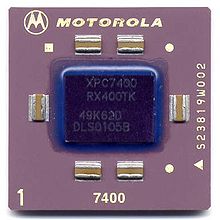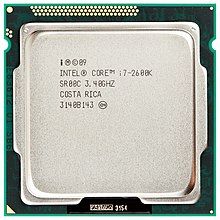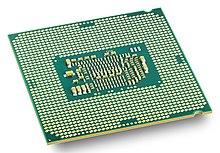Motorola 68k
Motorola 68000

The Motorola 68000 was the first Apple Macintosh processor. It has 32-bit CPU registers, a 24-bit address bus, and a 16-bit data path; Motorola referred to it as a "16-/32-bit microprocessor." [1]
| Processor | Model | Clock speed (MHz) | FSB speed (MT/s) | Introduced | Discontinued |
|---|---|---|---|---|---|
| MC68000 | Lisa [lower-alpha 1] | 5 | 5 | January 1983 | January 1984 |
| Lisa 2 [lower-alpha 1] [2] [3] | 5 | 5 | January 1984 | January 1985 | |
| Macintosh [lower-alpha 2] [4] | 8 | 8 | January 1984 | October 1985 | |
| Macintosh 512K [5] | 8 | 8 | September 1984 | April 1986 | |
| Macintosh XL [lower-alpha 3] | 5 | 5 | January 1985 | April 1985 | |
| Macintosh Plus [lower-alpha 4] | 8 | 8 | January 1986 | October 1990 | |
| Macintosh 512Ke [lower-alpha 5] | 8 | 8 | April 1986 | September 1987 | |
| Macintosh SE | 8 | 8 | March 1987 | August 1989 | |
| Macintosh SE FDHD | 8 | 8 | August 1989 | October 1990 | |
| Macintosh Classic [6] [7] [8] | 8 | 8 | October 1990 | September 1992 | |
| MC68HC000 | Macintosh Portable | 16 | 16 | September 1989 | October 1991 |
| PowerBook 100 [9] | 16 | 16 | October 1991 | August 1992 |
Motorola 68020
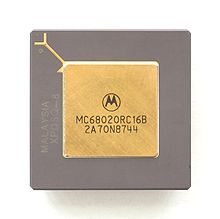
The Motorola 68020 was the first 32-bit Mac processor, first used on the Macintosh II. The 68020 has many improvements over the 68000, including an instruction cache, and was the first Mac processor to support a paged memory management unit, the Motorola 68851.
The Macintosh LC configured the 68020 to use a 16-bit system bus with ASICs that limited RAM to 10 MB (as opposed to the 32-bit limit of 4 GB).
| Processor | Model | Clock speed (MHz) | FSB speed (MT/s) | L1 cache (bytes) | Data path width/ Address width (bits) | PMMU | FPU | Introduced | Discontinued |
|---|---|---|---|---|---|---|---|---|---|
| MC68020 | Macintosh II | 16 | 16 | 256 | 32/16 | 68851 (optional) | 68881 | March 1987 | January 1990 |
| Macintosh LC | 16 | 16 | 256 | 16/16 | — | — | October 1990 | March 1992 |
Motorola 68030
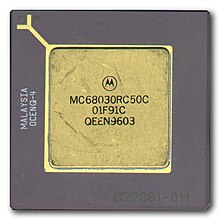
The Motorola 68030 was the first Mac processor with an integrated paged memory management unit, allowing for virtual memory. Another improvement over the 68020 was the addition of a data cache.
| Processor | Model | Clock speed (MHz) | FSB speed (MT/s) | L1 cache (bytes) | L2 cache (KB) | Data path width/ Address width (bits) | FPU | Introduced | Discontinued |
|---|---|---|---|---|---|---|---|---|---|
| MC68030 | Macintosh IIx | 16 | 16 | 512 | — | 32/32 | 68882 | September 1988 | October 1990 |
| Macintosh SE/30 | 16 | 16 | 512 | — | 32/32 | 68882 | January 1989 | October 1990 | |
| Macintosh IIcx | 16 | 16 | 512 | — | 32/32 | 68882 | March 1989 | February 1991 | |
| Macintosh IIci | 25 | 25 | 512 | 0–32 | 32/32 | 68882 | September 1989 | February 1993 | |
| Macintosh IIfx | 40 | 40 | 512 | 32 | 32/32 | 68882 | March 1990 | April 1992 | |
| Macintosh IIsi | 20 | 20 | 512 | — | 32/32 | 68882 (optional) | October 1990 | March 1993 | |
| Macintosh Classic II [9] Performa 200 | 16 | 16 | 512 | — | 16/32 | — | October 1991 | September 1993 | |
| PowerBook 140 [9] | 16 | 16 | 512 | — | 32/32 | — | October 1991 | August 1992 | |
| PowerBook 170 [9] | 25 | 25 | 512 | — | 32/32 | 68882 | October 1991 | October 1992 | |
| Macintosh LC II Performa 400 Performa 405 Performa 410 Performa 430 | 16 | 16 | 512 | — | 16/32 | — | March 1992 | March 1993 | |
| PowerBook 145 | 25 | 25 | 512 | — | 32/32 | — | August 1992 | June 1993 | |
| Performa 600/600CD | 32 | 16 | 512 | 32 | 32/32 | 68882 (optional) | September 1992 | October 1993 | |
| Macintosh IIvi | 16 | 16 | 512 | 32 | 32/32 | 68882 (optional) | October 1992 | February 1993 | |
| Macintosh IIvx | 32 | 16 | 512 | 32 | 32/32 | 68882 | October 1992 | October 1993 | |
| PowerBook 160 | 25 | 25 | 512 | — | 32/32 | — | October 1992 | August 1993 | |
| PowerBook 180 | 33 | 33 | 512 | — | 32/32 | 68882 | October 1992 | May 1994 | |
| PowerBook Duo 210 | 25 | 25 | 512 | — | 32/32 | — | October 1992 | October 1993 | |
| PowerBook Duo 230 | 33 | 33 | 512 | — | 32/32 | — | October 1992 | July 1994 | |
| Macintosh Color Classic Performa 250 Performa 275 | 16 | 16 | 512 | — | 16/32 | 68882 (optional) | February 1993 | May 1994 | |
| Macintosh LC III Performa 450 | 25 | 25 | 512 | — | 32/32 | 68882 (optional) | February 1993 | February 1994 | |
| PowerBook 165c | 33 | 33 | 512 | — | 32/32 | 68882 | February 1993 | December 1993 | |
| Macintosh LC 520 | 25 | 25 | 512 | — | 32/32 | 68882 (optional) | June 1993 | February 1994 | |
| PowerBook 180c | 33 | 33 | 512 | — | 32/32 | 68882 | June 1993 | March 1994 | |
| PowerBook 145B | 25 | 25 | 512 | — | 32/32 | — | July 1993 | July 1994 | |
| PowerBook 165 | 33 | 33 | 512 | — | 32/32 | — | August 1993 | July 1994 | |
| Macintosh LC III+ Performa 460 Performa 466 Performa 467 | 33 | 33 | 512 | — | 32/32 | 68882 (optional) | October 1993 | February 1994 | |
| Macintosh Color Classic II | 33 | 33 | 512 | — | 32/32 | 68882 (optional) | October 1993 | May 1994 | |
| Macintosh TV | 32 | 16 | 512 | — | 32/32 | — | October 1993 | February 1994 | |
| PowerBook Duo 250 | 33 | 33 | 512 | — | 32/32 | — | October 1993 | May 1994 | |
| PowerBook Duo 270c | 33 | 33 | 512 | — | 32/32 | 68882 | October 1993 | April 1994 | |
| Macintosh LC 550 Performa 550 Performa 560 | 33 | 33 | 512 | — | 32/32 | 68882 (optional) | February 1994 | March 1995 | |
| PowerBook 150 | 33 | 33 | 512 | — | 32/32 | — | July 1994 | October 1995 |
Motorola 68040

The Motorola 68040 has improved per-clock performance compared to the 68030, as well as larger instruction and data caches, and was the first Mac processor with an integrated floating-point unit.
The MC68LC040 version was less expensive because it omitted the floating-point unit.
| Processor | Model | Clock speed (MHz) | FSB speed (MT/s) | L1 cache (KB) | Introduced | Discontinued |
|---|---|---|---|---|---|---|
| MC68040 | Macintosh Quadra 700 | 25 | 25 | 8 | October 1991 | March 1993 |
| Macintosh Quadra 900 | 25 | 25 | 8 | October 1991 | May 1992 | |
| Macintosh Quadra 950 | 33 | 33 | 8 | May 1992 | October 1995 | |
| Macintosh Centris 650 | 25 | 25 | 8 | February 1993 | October 1993 | |
| Macintosh Quadra 800 Workgroup Server 80 | 33 | 33 | 8 | February 1993 | March 1994 | |
| Workgroup Server 95 [lower-alpha 6] | 33 | 33 | 8 | March 1993 | April 1995 | |
| Macintosh Centris 660AV Macintosh Quadra 660AV | 25 | 25 | 8 | July 1993 | September 1994 | |
| Macintosh Quadra 840AV | 40 | 40 | 8 | July 1993 | July 1994 | |
| Workgroup Server 60 | 20–25 | 20–25 | 8 | July 1993 | October 1994 | |
| Macintosh Quadra 610 | 25 | 25 | 8 | October 1993 | July 1994 | |
| Macintosh Quadra 650 | 33 | 33 | 8 | October 1993 | September 1994 | |
| Macintosh Quadra 630 | 33 | 33 | 8 | July 1994 | October 1995 | |
| PowerBook 550c | 33 | 33 | 8 | May 1995 | April 1996 | |
| MC68LC040 | Macintosh Centris 610 | 20 | 20 | 8 | February 1993 | October 1993 |
| Macintosh LC 475 Macintosh Quadra 605 Performa 475 Performa 476 | 25 | 25 | 8 | October 1993 | October 1994 | |
| Macintosh LC 575 Performa 575 Performa 576 Performa 577 Performa 578 | 33 | 33 | 8 | February 1994 | April 1995 | |
| PowerBook Duo 280 | 33 | 33 | 8 | April 1994 | November 1994 | |
| PowerBook Duo 280c | 33 | 33 | 8 | April 1994 | January 1996 | |
| PowerBook 520 | 25 | 25 | 8 | May 1994 | June 1995 | |
| PowerBook 520c | 25 | 25 | 8 | May 1994 | September 1995 | |
| PowerBook 540 | 33 | 33 | 8 | May 1994 | October 1994 | |
| PowerBook 540c | 33 | 33 | 8 | May 1994 | August 1995 | |
| Macintosh LC 630 Performa 630 Performa 630CD Performa 631CD Performa 635CD Performa 636 Performa 636CD Performa 637CD Performa 638CD Performa 640CD | 33 | 33 | 8 | July 1994 | February 1996 | |
| Macintosh LC 580 Performa 580CD Performa 588CD | 33 | 33 | 8 | April 1995 | April 1996 | |
| PowerBook 190 | 33 | 33 | 8 | August 1995 | June 1996 | |
| PowerBook 190cs | 33 | 33 | 8 | August 1995 | October 1996 |




